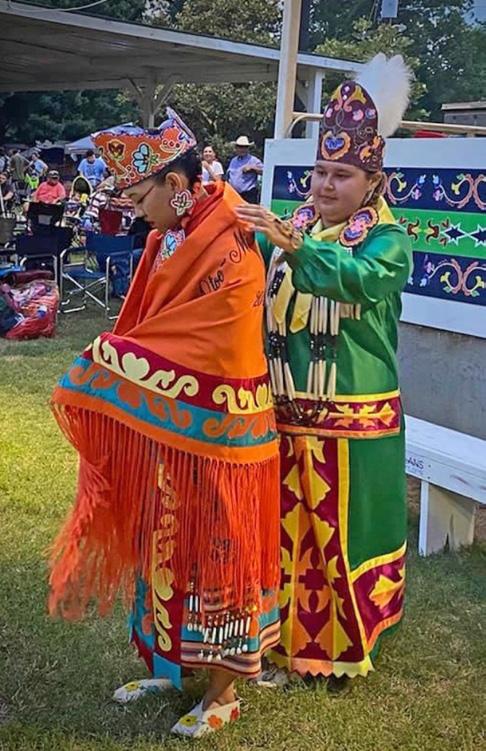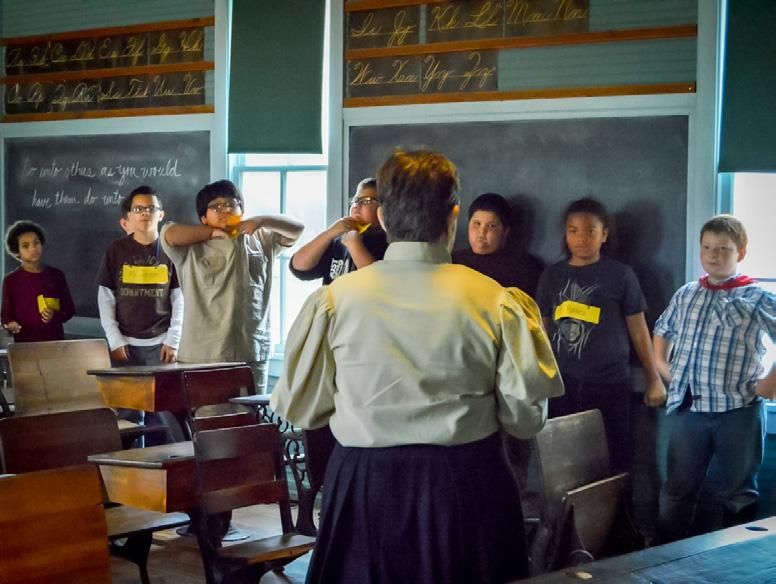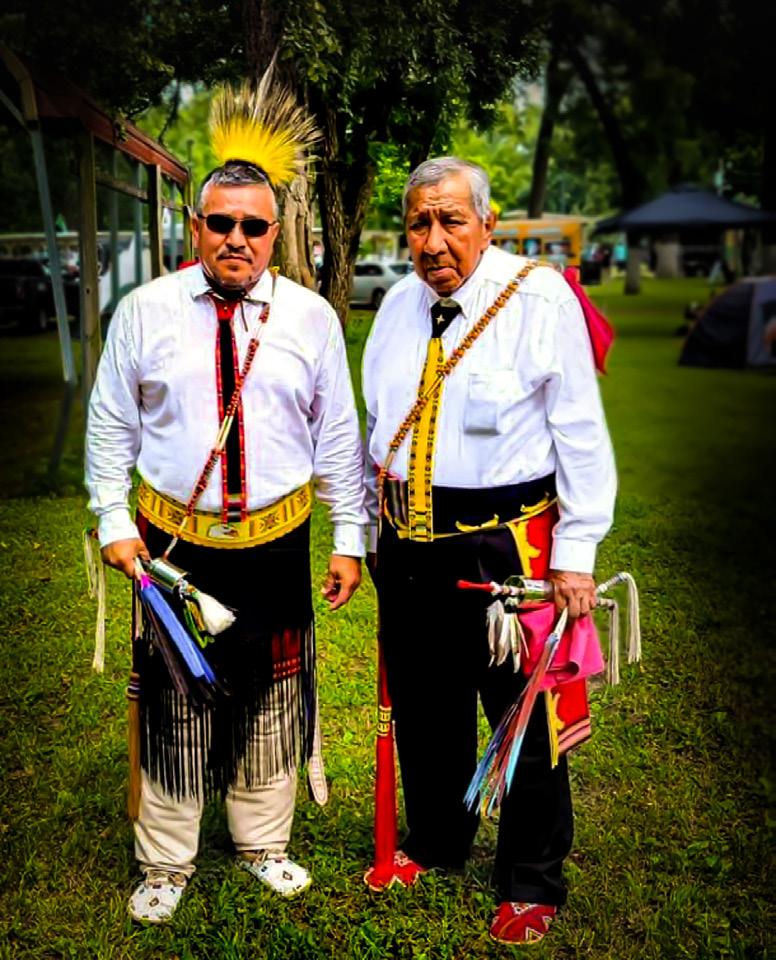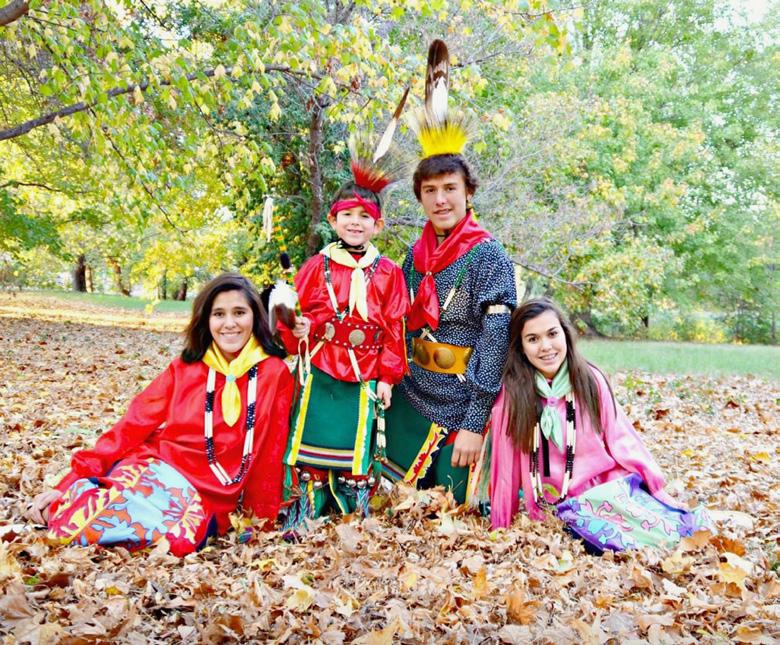
7 minute read
COVER STORY
from October 2022
by enidmonthly
STORY & PHOTOS
BY ABBY GREY
Advertisement
THE USIndigenous

A CELEBRATION OF INDIGENOUS PEOPLE'S DAY
The Day of the New Clan
Brothers and sisters of the tribe gather around a fire to hear the elders speak, as smoke slowly dissipates into the starry night sky. Drums beat a rhythmic story along with the constantly changing direction of the wind. Anticipation among them grows, awaiting a new saga of the pale skin foreigners their ancestors once encountered when cloudships first landed on the beaches of their homelands. Young children lean in closer, and closer, to hear their respected elder’s every word. The campfire reflects from the dilated pupils of the chief’s eyes, while mothers draw their babies in towards their bosom—every sentence lingers in the crisp air, and every word becomes imprinted onto the soul of the ears tuned in. To a mind that has never seen the billowing sails of an English ship, the Indigenous Americans saw only large clouds. The clouds—which carried the blessings of thunder and rain from the Gods—were, to their mind's eye, the only thing strong enough, and powerful enough, to carry the weight of so many men so gently across the ocean’s surface. However captivating and enigmatic these large ships might have been, how terrifying the wonderment was, too. Wondering how these ships captured a cloud from the sky to use on the water…, they all gasp, as they are told of the ways their ancestors approached these clouds with a reserved intrigue. Surely, these beings must have been brought from the sky; and, for this, they must belong to the heavens…
The Original Settlers: Indigenous
In 1499, Amerigo Vespucci contradicts the account of Christopher Columbus’ 1942 “discovery” of America and maintains he landed on a separate continent altogether. This claim is confirmed, Columbus landed in the West Indies (the Bahamas & the Caribbean)—thus giving name to AMERICA. exploring Cape Cod and finding a harbor point. English Pilgrims pile ashore, disembarking from their 66-day journey from Plymouth, England. Plymouth Colony is founded, and settlement has begun. More settlers arrive in the new world, and 13 colonies are established along the eastern coastline. Later, in 1775, frustrated settlers of the colonies begin a revolution against the King of England.
On July 4th, 1776, a Declaration of Independence is presented to England via the new Representatives of the government of the United States of America. By 1803, after acquiring the Louisiana Purchase, President Thomas Jefferson began exploring west of the Mississippi River. Merriwether Lewis and William Clark set out with Native American guides, to traverse the unknown lands of the west. On August 3, 1804, The Otoe and Missouria Tribes were the first tribes west of the Mississippi River to host a council with Lewis and Clark (The present day city of Council Bluff, Iowa takes its name from this historic meeting). They hosted two official councils, with the second one being the only successful one, due to Lewis and Clark’s lack of understanding of the political structure of Indigenous nations.

In 1838 and 1839, the United States government established, through a series of Indian Removal Policies on behalf of President Andrew Jackson, the forced relocation of approximately 60,000 Indigenous Americans off of their homelands. Jackson was aiming for the forced removal of all Native populations east of the Mississippi River to maximize land expansion for white settlers. What would become known as “The Trail of Tears” by the Cherokee people—due to the amount of anguish and death the journey brought to their tribes—was eventually referred to as the Five Civilized Tribes (Choctaw, Chickasaw, Seminole, Cherokee, and Creek). With a starting point in the Appalachian Mountains (area including the states of North Carolina, Tennessee, Georgia, and Alabama), and an ending point in the designated “Indian Territory” established in present-day Oklahoma, over 4,000 of the 15,000 Cherokee peoples died along the trail—leaving a trail of tears in the wake of their footsteps.
In 1845, Manifest Destiny took full hold among American politics, and full expansion into the west began—according to the advocates, destined by God, himself. In 1893, the Cherokee Outlet in Oklahoma (which remained mostly immune to the hardships of the red, white and blue battles during the Civil War) was eventually recognized by the federal government as a highly-valued plot of land, despite its reserved status as Indian Territory for the Native American Indian.

The New Day for Indigenous People
October 11th, 2021, President Joseph R. Biden signed a proclamation making Indigenous People’s Day a federally recognized holiday. “Our country was conceived on a promise of equality and opportunity for all people—a promise that, despite the extraordinary progress we have made through the years, we have never fully lived up to. That is especially true when it comes to upholding the rights and dignity of the indigenous people who were here long before the colonization of the Americas began”, President Biden says in the proclamation. “On Indigenous Peoples’ Day, our Nation celebrates the invaluable contributions and resilience of Indigenous Peoples, recognizes their inherent sovereignty, and commits to honoring the Federal Government’s trust and treat obligations to Tribal Nations.” This Tuesday, October 11th, 2022, will mark the second celebration of Indigenous Peoples Day as a federally recognized holiday in the United States of America.
Enid is home to many museums, and we—as a community—are quite fortunate to benefit from the opportunities we provide for those passing through Northwest Oklahoma. Jake Krumwiede explains an important reason why Indigenous Peoples’ Day is a vital holiday installment onto the United States of America’s yearly calendar; he states, “The ‘Cherokee Strip’ from our name is referring to the Cherokee Strip or Cherokee Outlet, which represents much of northwestern Oklahoma, which is land that the Cherokee Nation once had rights to.” As



Museum Director for the Cherokee Strip Regional Heritage Center (located at 507 South Fourth Street in Enid, OK), Jake devotes his work life to sharing knowledge and spreading educational programs to the community. Jake shared his happiness to speak with Enid Monthly about this topic, easily generating a willingness to give a hand and offer connections to help develop this story for the community to benefit. Reinforcing the importance of shared connection and knowledge on even the dark subjects from history, continuing a tradition that has remained common among native cultures—story-telling.
The Cherokee Strip Museum in Enid shares the lives and stories of the re-settlement of Oklahoma lands, during a short series of events known as the Oklahoma Land Runs. The land Enid, OK rests on today was once the homeland to our Native American neighbors. With a history of Oklahoma being known as “Indian Territory”, Oklahoma, in itself, hosts a wide range of cultural museums with strong Native American origins and influences. Many Oklahoma towns found their own claim to fame in housing these museums; towns, such as; Tuskahoma (Choctaw Nation Museum), Wewoka (Seminole Nation Museum), Carnegie (Kiowa Tribal Museum), and Tahlequah (Cherokee Heritage Center) respectively pay tribute the native cultures housed within their walls. (Full List of Native Museums in Oklahoma can be found at the end of this article.) But, the narrative at this museum shares information on another part of American history. “Following the American Civil War, there was a lot of political pressure for the tribe to cede the Outlet back to the federal government, so the territory could be opened up for public settlement. The Cherokee Outlet Land Run of 1893 is when that occurred.” Jake continues, “to many indigenous peoples, land runs represent another example of broken promises from the U.S. government and lost land rights. Our museum…largely focuses on the settling of northwestern Oklahoma following the 1893 run.

The Elder Childs of Otoe-Missouria
Indigenous cultures have always valued gathering around the fire for stories, and they never shy away from telling the whole story—even if the truth isn’t something you always want to hear. Powwows are held yearly, and in Oklahoma, there is a variety of Nations (within our own Nation) you can visit to witness their cultures first-hand. Another form of a Native powwow is known as an “encampment”. Encampment is a time in which all Otoe-Missouria clans come together at the traditional encampment location in Red Rock, OK. This is all to serve their individual clan’s role. Each clan is responsible for a different part of the tribe, and this system means that each clan has a duty to fulfill to ensure the overall success of the event. Local Enid residents, The Childs family, belong to the Eagle clan, and the Eagle Clan oversees the ceremonies. Marie Childs, before marriage to Henry Childs, was a member of the Bear clan. Being that Henry is Eagle clan, Marie inherited life among the Eagle clan as well as a loving, new family in her husband and eventual children Donnie, Johnnie, and Jana. Their son Donnie briefly explains how, according to Otoe-Missouria Legend, “the Bear clan and Eagle clan have always been two clans that have gotten along well, and marriage is common among these clans.” As the patriarch of the ........................................................................................ continued on Page 14










